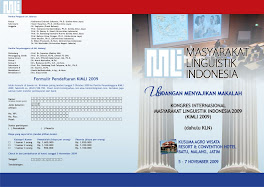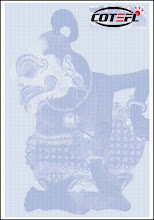CHILDREN’S LITERATURE IN EFL CLASSROOM: THE STYLISTIC CONSIDERATIONS
Laily Martin
English Department, Faculty of Letters,
Abstract
Children’s literature, meaning literary works written for children viewers (up to twelve years old) is commonly used as a teaching source for teaching English in EFL context. The works used are commonly in the form of short stories, written or sung out further in class. Beside its interesting feature, the works are rich in providing language materials, which can be analyzed stylistically, in relation to children’s language forms and language level. From the three sample stories; The Teeny Weeny Tadpole, The Tickly Octopus, and The Very Lazy Ladybird, the language show its characteristics of (1) simplicity, but creatively-built, (2) casualty, the daily-used in interaction, and (3) rhythmical in productions. These features can be represented in the prominent linguistic forms: (a) registers specific to children and (b) onomatopoeias. Thus, it is suggested that the books are best suit to English teaching for children of kindergarten or early elementary.
Introductions
Children’s literature, focused on the literary works written for children viewers, up to twelve years old
(Lynch-brown and Tomlinson 1993:1, http://en.wikipedia.org/wiki/Children%27s_literature), is commonly used as a teaching source due to its important roles in personal and cognitive development. It may help children in interpreting, reflecting and affirming their own feelings as well as introducing them to the interaction with others and world knowledge (Dowling 2000:139). Literary works also provide an exposure for language usage; that different language forms will effect on different communicative goals (McKay 2001:319). These advantages made such literary works are commonly used in Indonesian EFL classes; those which are written either by the English native speakers or Indonesian writers. From the various choices, the hard job is in the hand of teachers; doing adjustment between the appropriate works and learners needs. One of the considerations is about the linguistic choices relevant to the learners, as a results from having a stylistic analysis. Due to the width of stylistics, the present study will focus on the analysis at the vocabulary level.
Stylistics Analysis in Children’s Literature Selection
At the beginning, there was a reject on stylistic analysis due to the possible effect that doing stylistic analysis will make learners give more concern on language form rather than the content of communication. As the result, reading a literary work may no longer become an enjoyable activity for readers. This opinion then proved works in reverse that the concern on language forms –being aware of language forms—will encourage learner’s effort in comprehending a text, either spoken or written. In fact, the knowledge on style may support learners to use language properly; increasing reader’s awareness on the linguistic effects and giving opportunity to prove the reader’s subjective interpretation by implying objective analysis (linguistics)(Gower 1986:126-127). Then how does stylistics work in selecting literary work for EFL classes?
Stylistic, in general, refers to the study of the varieties of linguistic forms and their relevancies on the interpretation of a literary work (Wales 1989 in Thornborrow and Wareing 1998:3, Verdonk 2002:4). In other words, in doing a stylistic analysis an analyst applies certain linguistic analysis in interpreting the distinctive linguistic features in a target text. The results may reveal the causal factors behind the text’s creation, in text interpretation, and even on the effect of the text. Such analyses are important in selecting learning sources, in terms of ‘how’ they are chosen, especially on the language aspect (Gower 1986:127-128). In order to fulfill this need, it is important to relate the language with the children’s psycholinguistic factors; their cognitive and language level development.
Cognitive development refers to the children’s mental stages, their brain capacity and abilities. Sensory motor (0-2), preoperational (2-6/7), concrete operational (6/7-11/12), and formal operational (11/12-adulthood) stages (Piaget in McDevitt and Ormrod 2002:114). In relation to language, McDevitt and Ormrod (p.262-263) divided the children’s language level development into: the early childhood (2-6), rapid memorization on vocabulary and syntax; middle childhood (6-10), concrete vocabularies processing; and early adolescence (10-14), the abstract concept processing. With this brief description of the psycholinguistic background, the appropriate style of children’s language forms and levels can be matched.
A Stylistic Analysis on the Three Erlangga for Kids’ Story Books
Erlangga for kids’ stories are bilingual story books published by Erlangga. These books were written by native speaker of English, mainly from
In terms of vocabulary, the language used in books shows some characteristics of children’s language which are summarized as (1) simple but creatively-built, (2) used in daily casual interaction, and (3) rhythmical in productions. These features can be represented in various linguistic forms dominantly found in the three texts, prominently, (a) registers specific to children and (b) onomatopoeias; registers are vocabularies which are identified specific for children users and onomatopoeias are those derived from the imitation of the real objects’ sound. Here are some examples:
1. Simple vocabularies are realized by the simplicity of sounds, which are children’s tongue-like, and simplicity of concept. For example, in TWT: teeny weeny, tummy, wooly-face (goat), bug-eyed (eyes of grasshopper); tickly (love to tickle), twirly, super-speedy (very vast) (TO); bumpy, snooze (VLL).
2. Vocabularies used in the three story books are also those used commonly in daily interaction, with the concrete function on casual interaction, like splish splash, look out, watch (TWT); snap, tumble down, huff, puff (TO); all day, all night (VLL)
3. Rhythmical effects. Vocabularies found in the three books also rich in rhythm. It may be used to attract interest (sound play) as well as mimic the real object’s characteristic, especially movement. The words are like flippity-flop (for goat), springity-sprong (grasshopper), jumpity-bumb (for rabbit) (TWT); clickety-clackety (crab) (TO); bounded by (kanggoroo)-padded by (tiger)-swam by (crocodile)- swung by (monkey)- amble by-plodded by-trundled by (elephant) (VLL)
Conclusion
From the language of the three Erlangga for Kids’ Story Books, it can be concluded that the books seems best suit for children whom are in the process of storing vocabularies. In EFL context, the process is found in kindergarten and early elementary level, due to the books’ simple, concrete, and playful vocabularies. Thus, the books may provide the accessible (in-context language uses), theme engaging, and balance conceptual and linguistic levels (McKay 2001:322).
References
Cain, Sheridan and Jack Tickle. 2006. The Teeny Weeny Tadpole. Translated by Eka Cahyani “Kecebong Kecil Mungil.”
Dowling, Marion. 2000. Young Children’s Personal, Social and Emotional Development.
Finn, Isobel and Jack Tickle. 2006. The Very Lazy Ladybird. Translated by Eka Cahyani “Kepik yang Sangat Pemalas.” Jakarta: Erlangga
Galloway, Ruth . 2006. Tickly Octopus. Translated by Eka Cahyani “Gurita yang Suka Menggelitik.” Jakarta: Erlangga
Gower, Roger. 1986. “Can Stylistic Analysis Help The EFL Learner To Read Literature?” ELT Journal, Vol. 40/2, April, P.125-130
McDevitt, Teressa M. and Jeanne Ellis Ormrod. 2002. Child Development and Education. Ohio: Merrill Prentice Hall
McKay, Sandra Lee. 2001. “Literature as Content For ESL/EFL”. In Marianne Celce-Murcia (ed.) Teaching English as a Second or Foreign Language, 3rd edn. P.319-332. Boston: Heinle & Heinle
Thornborrow, Joanna and Shan Wareing. 1998. Patterns in Language: An Introduction to Language and Style. London: Routledge
Verdonk, Peter. 2002. Stylistics. Oxford: Oxford University
http://en.wikipedia.org/wiki/Children%27s_literature










No comments:
Post a Comment